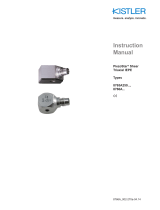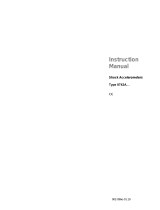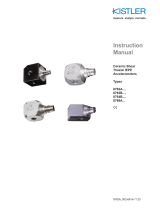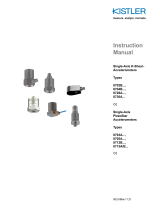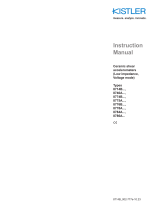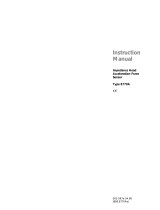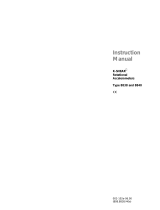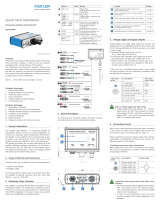Page is loading ...

Instruction
Manual
PiezoStar Shear
Triaxial IEPE
Types
8765A250...,
8766A...
ä
8766A_002-270e-01.19

Instruction
Manual
PiezoStar Shear
Triaxial IEPE
Types
8765A250...,
8766A...
ä
8766A_002-270e-01.19


Foreword
Foreword
8766A_002-270e-01.19
Thank you for choosing a Kistler quality product characterized
by technical innovation, precision and long life.
Information in this document is subject to change without notice.
Kistler reserves the right to change or improve its products and
make changes in the content without obligation to notify any
person or organization of such changes or improvements.
© 2014 ... 2019 Kistler Group. Kistler Group products are pro-
tected by various intellectual property rights. For more details
visit www.kistler.com. The Kistler Group includes Kistler Hold-
ing AG and all its subsidiaries in Europe, Asia, the Americas and
Australia.
Kistler Group
Eulachstrasse 22
8408 Winterthur
Switzerland
Tel. +41 52 224 11 11
info@kistler.com
www.kistler.com
Page 1

8766A_002-270e-01.19Page 2
PiezoStar Shear Triaxial IEPE Accelerometers, Type 8765A..., 8766A...
Content
1. Introduction .......................................................................................................................................4
2. Important information ......................................................................................................................5
2.1 For your safety .......................................................................................................................5
2.2 Precautions ............................................................................................................................6
2.3 Disposal of electronic equipment ...........................................................................................6
3. Product description ..........................................................................................................................7
3.1 PiezoStar shear background ..................................................................................................7
3.2 Low impedance (IEPE) output................................................................................................8
3.3 Accessories ............................................................................................................................9
3.3.1 Studs .......................................................................................................................10
3.3.2 Cables .....................................................................................................................11
3.3.3 Nomenclature .........................................................................................................11
4. Installation.......................................................................................................................................12
4.1 Surface preparation ..............................................................................................................12
4.2 Screw and stud mounting .....................................................................................................13
4.3 Direct adhesive mounting .....................................................................................................14
4.4 Mounting with wax ................................................................................................................15
4.5 Mounting with magnet ..........................................................................................................15
4.6 Summary of mounting methods ...........................................................................................17
4.7 Securing cables ....................................................................................................................18
4.8 Mass loading effects .............................................................................................................19
5. Operating instructions ...................................................................................................................20
5.1 Powering ..............................................................................................................................20
5.1.1 Using "Built-In" power sources................................................................................20
5.1.2 Kistler couplers .......................................................................................................21
5.1.3 The constant current power supply/coupler ............................................................21
5.1.4 Sensor power-up ....................................................................................................24
5.1.5 Overload recovery ..................................................................................................24
5.1.6 Supply voltage effects .............................................................................................25
5.1.7 Driving long cables .................................................................................................25
5.1.8 Ground loops ..........................................................................................................27
5.1.9 Ground isolation ......................................................................................................29
5.1.10 Frequency response limits ....................................................................................29
5.1.11 Frequency response denition and standards ......................................................30
5.1.12 High Frequency limitations ...................................................................................30
5.1.13 Low Frequency limitations - accelerometer ..........................................................31
5.1.14 Low frequency limitations - coupler and read-out instrumentation .......................33

Page 38766A_002-270e-01.19
Content
Total pages: 45
6. Measurement ..................................................................................................................................34
6.1 Piezoelectric measurement concept ....................................................................................34
7. Technical data .................................................................................................................................35
8. Calibration and maintenance ........................................................................................................36
8.1 Calibration ............................................................................................................................36
8.2 Maintenance .........................................................................................................................36
9. Troubleshooting .............................................................................................................................37
10. Storage & transit considerations ................................................................................................38
11. Warranty ........................................................................................................................................39
12. Declaration of conformity ............................................................................................................40

8766A_002-270e-01.19
PiezoStar Shear Triaxial IEPE Accelerometers, Type 8765A..., 8766A...
Page 4
Thank you for choosing a quality product from Kistler. Please
read through this manual thoroughly to enable you to fully
exploit the various features of your product.
To the extent permitted by law Kistler accepts no liability if
this instruction manual is not followed or products other than
those listed under Accessories are used.
Performance features at a glance:
Hermetic, titanium construction
PiezoStar element with low sensitivity to temperature
IEPE, 50 g to 1,000 g ranges
Miniature, lightweight design
High operating temperature option (165 °C / 330 °F)
Mini and standard, 4 pin connector options for lower mass
and wider frequency operation
Conforming to ä
Kistler offers a wide range of products for use in measuring
technology:
Piezoelectric sensors for measuring force, torque, strain,
pressure, acceleration, shock, vibration and acoustic
emission
Strain gage sensor systems for measuring force and
torque
Piezoresistive pressure sensors and transmitters
Signal conditioners, indicators and calibrators
Electronic control and monitoring systems, as well as
software for specic measurement applications
Data transmission modules (telemetry)
Kistler also develops and produces measuring solutions
for the application elds engines, vehicles, manufacturing,
plastics and biomechanics sectors.
Our product and application brochures, in addition to our
detailed data sheets, will provide you with an overview of our
product range.
If you require additional help beyond what can be located
online or in this manual, please contact Kistler‘s extensive
support organization or visit us online at www.kistler.com.
1. Introduction

8766A_002-270e-01.19
Important Information
Page 5
2. Important information
This product has been manufactured in compliance with
current valid safety regulations. It has left the factory in a
perfect, safe condition. In order to maintain this condition and
ensure safe operation, compliance is required with the inst-
ructions and warning notes contained within this manual or
imprinted on the product itself.
Compliance with local safety regulations, which may apply
to the use of power line operated electrical and electronic
equipment, is strongly recommended.
It is essential for you to review the following information, which
is intended to ensure your personal safety when working
with the PiezoStar Shear Triaxial IEPE Accelerometers and
contribute toward a long-fault-free service life.
2.1 For your safety

8766A_002-270e-01.19
PiezoStar® Shear Triaxial IEPE Accelerometers, Type 8765A..., 8766A...
Page 6
2.3 Disposal of electronic equipment
2.2 Precautions
Compliance with the following precautionary measures is
vital to ensure safe and reliable operation:
▪ Never expose the instrument to contamination or oil mist.
▪ Never operate or store the instrument outside the specified
temperature range.
▪ Never exceed the maximum stated voltage
▪ Connect the instrument only to equipment for which it was
designed to be used.
▪ Never allow the product to drop.
▪ The environment should be as dry, clean and free from
vibrations as possible.
▪ Never operate the instrument if there are visible signs of
damage.
If there is evidence that safe operation is no longer possib-
le, the instrument must be powered off and rendered safe
against accidental start-up. Safe operation is no longer pos-
sible when the product:
▪ shows visible signs of damage
▪ is no longer operating
▪ has been subjected to prolonged storage under unsuitable
conditions
Do not discard old electronic equipment in municipal trash.
For disposal at end of life, please return this product to the
nearest authorized electronic waste disposal service or
contact your Kistler sales ofce for disposal instructions.

8766A_002-270e-01.19
Product Description
Page 7
3. Product description
3.1 PiezoStar shear background
Kistler PiezoStar Shear Triaxial IEPE accelerometers are
shear mode shock and vibration measuring instruments.
A self-generating piezoelectric sensing element is used
in conjunction with the built-in, internal circuit Piezotron
impedance converter.
As with most accelerometers, the sensitivity of this series is
expressed in terms of the ratio of the electrical output to the
applied acceleration (i.e. mV/g). Piezotron devices offer a low
impedance output voltage signal, which is proportional to the
applied acceleration. A charge amplier or special cabling is
not required and transmission over long lines is possible with
minimal noise pick-up.
A typical Kistler sensing assembly (see Fig. 1) consists
of a center post, PiezoStar element and a seismic mass
mechanically preloaded, with or without a preload bolt. Since
the unit is operated in a shear arrangement it will sense
motion perpendicular to the base. When the accelerometer
is attached to a vibrating structure, the mass exerts a
shear force on the PiezoStar. This applied force causes the
piezoelectric material to produce an electric charge. Force
= mass x’s acceleration (from Newton's second law). Since
m is the constant, the charge produced is proportional to
acceleration. This is represented by the equation:
a = F
—
m
Fig. 1: Inside view of a typical single-axis shear accelerom-
eter

8766A_002-270e-01.19
PiezoStar® Shear Triaxial IEPE Accelerometers, Type 8765A..., 8766A...
Page 8
3.2 Low impedance (IEPE) output
Contained within the accelerometer housing is a miniature
electronic circuit. This circuit converts the high impedance
charge signal generated by the piezoelectric element into a
low impedance voltage output signal. All accelerometer types
have a nominal output less than 100 ohms.
The integral impedance converter is powered by an external
power source (coupler) that uses a two-wire cable between
the accelerometer and coupler. The signal and power source
share a common line. The coupler provides a constant
current source to the accelerometer and decouples the DC
bias (see Section 5.1.3) from the measuring instrument. The
useable signal is seen as a varying voltage over an 11 VDC
(nominal) bias.
Low impedance accelerometers are ideally suited for
applications where long or moving cables are required, in
high humidity or other impure atmospheres. They eliminate
the difculties associated with a high impedance output
by providing a voltage signal with low impedance and a
high frequency response. The calibration factors for these
accelerometers are given in mV/g.
Table 1 depicts a typical low impedance measurement
system. Couplers vary considerably in appearance,
depending upon the application and the number of sensors
making up the system. It can also be directly integrated to the
data acquisition system.
The PiezoStar Shear sensing element, similar to the
K-Shear element shown in Fig. 1, offers many advantages
over previous compression mode designs. Due to its shear
construction, the accelerometer element is insensitive to
thermal transients, transverse (cross-axis) motion, and the
effects of base strain.
Kistler initially introduced this K-Shear design using a quartz
element that has become a standard with many users. Kistler
PiezoStar accelerometers utilize the same basic construction
as our K-Shear accelerometers, with the exception of one key
difference: PiezoStar accelerometers utilize a new proprietary
piezoelectric crystal, which produces higher charge output
when compared with quartz-based accelerometers, and
also offer a higher operating temperature. When mated with
internal Piezotron electronics, the accelerometer has the
additional benet of much lower temperature coefcient of
sensitivity when compared with quartz and ceramic-based
accelerometers.

8766A_002-270e-01.19
Product Description
Note: Type 1784B…K03 is used for Types 8765A or 8766AxAx; Type 1756C… and Type 1734A… are used for Types 8766AxBx
and 8766A...CBsp
IEPE Sensor and Customer IEPE Compatible DAQ
IEPE Sensor and Kistler LabAmp
Page 9
Table 1: IEPE sensor/customer IEPE compatible DAQ and
IEPE sensor and Kistler LabAmp measuring chains
3.3 Accessories
All accelerometers designed for stud mounting are supplied
with the appropriate studs. All accelerometers designed for
screw assembly mounting are supplied with a mounting
screw. All units intended for adhesive mounting are provided
with mounting wax. See Table 2 for more details regarding
mounting stud dimensions or refer to the unit specifications
listed on the respective data sheet for each model.
Measuring Connecting Amplifying Acquiring Analyzing
Type 8765A...,
8766A...
Types 1734A..., 1756C...,
1784B...K03 (4 pin neg. to
3x BNC pos.)
IEPE Compatible Data Acquisition
Unit (customer supplied)
Laptop (customer supplied)
Measuring Connecting Amplifying Acquiring Analyzing
Type 8765A...,
8766A...
Ethernet Cable Notebook with LabAmp GUI
Type 5165A...
Conditioning and Data Acquisition
Analog Output ±10 V
Type 1511
Types 1734A..., 1756C...,
1784B...K03 (4 pin neg. to
3x BNC pos.)
5050B
8202A
8702B
5165A
Data Accquisition Unit
8763 B
8395A
8315A
5146A15
5134B
1631C
1761B
1592A
1792A
Ethernet Kabel
1756C
1635C
1511

8766A_002-270e-01.19
PiezoStar Shear Triaxial IEPE Accelerometers, Type 8765A..., 8766A...
Page 10
Type A B C D E Used with
700-1603-003 -- -- 12 -- M2.5 8765A250M5
700-1604-002 -- -- 12.7 -- 4–40 8765A250M5
8430K03 2.28 3.56 6.86 6–32 10–32
8766A50...,
8766A050...,
8766A100...
8416 2.28 3.81 6.6 5–40 10–32
8766A250...,
8766A500...,
8766A1K0...
8418 3.3 3.81 7.11 5–40 M6
8766A250...,
8766A500...,
8766A1K0...
8420 -- -- 9.65 5–40 5–40
8766A250...,
8766A500...,
8766A1K0..
3.3.1 Studs
Table 2: Mounting studs (dimensions in mm)

8766A_002-270e-01.19
Installation
Page 11
3.3.2 Cables
Type 1784B(x)K03 · Mini 4 pin to 3x BNC cable (available
lengths: x = 1, 3, 5, 10 m)
Type 1784AK02
· Transition cable 0.5 m length
· Mini 4 pin to ¼−28 Microtech compatible
4 pin connector
· Intended for use with Type 1756B(x) cables
Type 1756C(x)K03/K04
· Fluoropolymer jacket
· 4 pin neg. 3x BNC pos.
· Triaxial accelerometer cable
Type 1756B7Q1
Type 1756Bsp(x)Q1
· Fluoropolymer jacket
· 4 pin neg. 3x BNC pos.
· Triaxial accelerometer cable
Type 1734A(x)K03
· Silicone jacket
· 4 pin neg. 3x BNC pos.
· Triaxial accelerometer cable
Type 1578Asp(x) · Optional 4 pin extension cable (4 pin pos.
Microtech to 4 pin neg. Microtech)
Type 1511sp · Output cable BNC pos. to BNC pos.
* Please refer to data sheet 000-471 for more details. Contact Kistler for any of your
cable needs.
Table 3: Most commonly used cables from Kistler (x = cable
length in meters)
3.3.3 Nomenclature
Throughout this manual, special designations and
nomenclature are used for terms and concepts relating to
PiezoStar Shear sensors. These are identied in Table 4.
Term Definition
Fs Full-scale
Es DC supply voltage (a/k/a compliance voltage)
Eb Bias voltage (from calibration certicate)
fFrequency in Hz
R1Output resistance of the coupler
R2Input resistance of the coupler
ICurrent in Amperes
CCapacitance in Farads
τTemperature
EOutput in Volts, Peak
R Read-out impedance
Z Input impedance
PiezoStar Special piezoelectric crystals
IEPE Integrated Electronics Piezoelectric
TEDS Transducer Electronic Data Sheet
Table 4: Manual nomenclature

8766A_002-270e-01.19
PiezoStar Shear Triaxial IEPE Accelerometers, Type 8765A..., 8766A...
Page 12
4. Installation
This section provides the user with a quick means of placing
the Kistler PiezoStar Shear Triaxial IEPE accelerometers
into operation. Careful installation will result in optimal, high
frequency response, accuracy and reliability. Dimensional
characteristics can be found on their respective data sheets.
Type 8765A20M5
screw, wax or adhesive mounting
Type 8766A50...
stud or adhesive mounting
Type 8766AxA...
stud, wax or adhesive mounting
Type 8766AxB...
stud, wax or adhesive mounting
Table 5: Mounting options
4.1 Surface preparation
A clean, at surface is necessary for both stud and adhesive-
mounted accelerometers. If the surface is not completely at,
the coupling between the accelerometer and the test article
introduces distortion into the measurement. A rough surface
creates voids between the mounting surfaces that reduce
high frequency transmissibility.
For optimal frequency response with stud mount units, the
surface and hole preparation should be performed according
to the instructions in Table 6. The roughness should not
exceed 32 micro inches (0.8 micrometers).

8766A_002-270e-01.19
Installation
Page 13
4.2 Screw and stud mounting
Type 8765A250M5 has a center through-hole design that
accepts a screw with a special off-ground treatment to
ensure off-ground operation when installed. The 8766A50…,
8766A050…and 8766A100 have three 6-32 UNC threaded
holes for stud mounting. Types 8766A250… and 8766A500...
and 8766A1K0... have three 5-40 UNC threaded holes for
stud mounting. Most Kistler mounting studs are machined
from Beryllium Copper for high strength and low modulus
of elasticity, coupled with high elastic limits. The studs are
removable, allowing both stud and adhesive mounting. The
following guidelines must be followed when stud mounting
accelerometers:
1. Drill and tap an adequate hole to ensure a ush mount
of the accelerometer. Make sure the stud for mounting of
Type 8766A… does not bottom out, either in the mounting
hole of the test structure or in the accelerometer base. A
chamfer should be machined at the top of the mounting
hole to ensure that the base of the accelerometer makes
full contact with the mounting surface (see Table 3).
2. Completely clean the surface prior to mounting.
3. Apply a thin coat of silicon grease to both the acclerometer
and the mounting surface.
4. Always use the proper sockets and a torque wrench when
installing accelerometers. DO NOT OVERTIGHTEN.
a. Type 8765A250M5: tighten the accelerometer to a
torque of 18±2 in-lb or 2±0.2 N·m
b. Type 8766A...: tighten the accelerometer to a torque
torque of 7.5±0.5 in-lb or 0.85±0.06 N·m

8766A_002-270e-01.19
PiezoStar Shear Triaxial IEPE Accelerometers, Type 8765A..., 8766A...
Page 14
Stud type D L1 mm L2 mm
700-1603-003 M2.5 4.0 8.0
700-1604-002 4–40 4.0 8.0
8430K03 10–32 6.0 8.0
8416 10–32 6.0 8.0
8418 M6 6.0 8.0
8420 5–40 6.0 8.0
Table 6: Stud mounting preparation
4.3 Direct adhesive mounting
The surface should be smooth and at. A cyanoacrylate
type adhesive, such as Eastman 910 or Loctite 496 super
glue, is recommended. While epoxies can also be used,
cyanoacrylate adhesives provide an extremely thin bond
which provides optimal frequency response.
Knowing the operating temperature of the accelerometer
aids in the appropriate selection of the adhesive. Some
adhesives lose holding force at elevated temperatures. The
accelerometer could fall from the test article and experience
a damaging shock. Measuring information could be awed if
the accelerometer is not held in close contact to the surface
under study.
When adhesive mounting an accelerometer with a tapped
hole, make certain that no adhesive is allowed to enter the
hole. This could eventually make stud mounting difcult.

8766A_002-270e-01.19
Installation
Page 15
Remove the sensor with a manufacturer’s recommended
adhesive solvent. Acetone is effective for the removal of
cyanoacrylate adhesives. Use the proper sized wrench to
loosen the sensor from the adhesive mount. Do not impact!
4.4 Mounting with wax
Bee's wax has been used as a mounting agent for many
years. The provided Petro Wax (Kistler Type 8432 or P/N
P102 from Katt and Associates; P.O. Box 623, Zoar, Ohio
44697, or equivalent) is a good replacement for bee's wax. It
is formulated to provide improved frequency response.
Wax is a good mounting agent for lightweight sensors in
temporary installations where near room temperatures are
encountered. Type 8764A is specically designed for wax/
adhesive mounting.
4.5 Mounting with magnet
Magnet Type 8452 can be used for Type 8766A... mounting
sensors. These offer a convenient, temporary attachment to
a ferromagnetic test structure. A notched mounting unit is
available for mounting on curved surfaces. Magnetic bases
nd use in applications requiring vibration monitoring of large
rotating machinery. Note that usage of some mounting bases
can add considerable mass and reduce high frequency
response.
This mounting method is convenient, but it also can be very
destructive to the sensor when mounting to a structure. A
direct approach to the ferromagnetic surface can generate a
metal to metal sharp shock as high as 5,000 g.
Specific caution needs to be taken when unmounting 50 g
sensors due to the very high ouput piezostar element and the
very sensitive electronic. Avoid cracking the adhesive for re-
leasing the sensor. If possible use adhesive mounting plate
and remove the sensor from the base before removing the
adhesive.

8766A_002-270e-01.19
PiezoStar Shear Triaxial IEPE Accelerometers, Type 8765A..., 8766A...
Page 16
When attaching to a structure where the magnetic mounting
base is already threaded onto the sensor, a sharp metal to
metal impact can occur that can lead to sensor overload and
damage. In order to prevent it, always try to rst mount the
magnet onto the surface then thread the sensor onto the
magnet mounting base or approach the mounting surface
with an angle as illustrated below.
Fig. 2: Magnetic mounting preparation

8766A_002-270e-01.19
Installation
Page 17
Table 7: Mounting methods
4.6 Summary of mounting methods
Mounting
Method
Accessory Type Advantages Disadvantages Remarks
Probe Quick measurement Lower accuracy
Magnetic base 8450A, 8452A, 8456,
KIG4662Bx, 8458,
8466K03, ...
Easy & quick
installation
Adds considerably to mass
loading, lowers resonant
frequency
Limited to ferromagnetic
materials
Adhesive
mounting base
8440K0x, 8466K01, 8434,
8436, 8438, ...
Allows stud mounting,
provides electrical isolation
Lowers resonant frequency Pads are usually exposed to
test specimen
Adhesive wax 8432 Petrowax, bees wax Ideal for lightweight
units
Limited temperature range;
not sutable for larger sensors
Fast & clean
Adhesive
cement
Loctite, Permabond
(cyanoacrylate), hot melt,
Epoxy
Good, strong coupling of
sensor to specimen;
higher temperature
capability than wax
Difficult to remove sensor;
requires solvents, removal
tool and/or heat
Suited for more permanent
applications & high
frequency measurements
Isolated
mounting stud
8400K0x Allows both strong
coupling & ground
isolation
Requires threaded hole in
specimen; base slightly
lower resonance frequency
Control mounting torque;
use silicone grease
Mounting stud 8402, 8404, 8406, 8410,
8411, 8416, 8418, 8421,
8451, 8453
Best couping of sensor to
test speciment for highest
frequency response
Requires threaded hole in
specimen
Control mounting torque;
use Silicone grease
*Please refer to data sheet 000-471 for more information.
Probe Magnetic base
with foil
Adhesive mounting
base
Direct adhesive
mounting
Isolated stud
mounting base
Stud mounting
Magnetic base
Stud mounting must conform to manufacturer's complete
specications.
/
